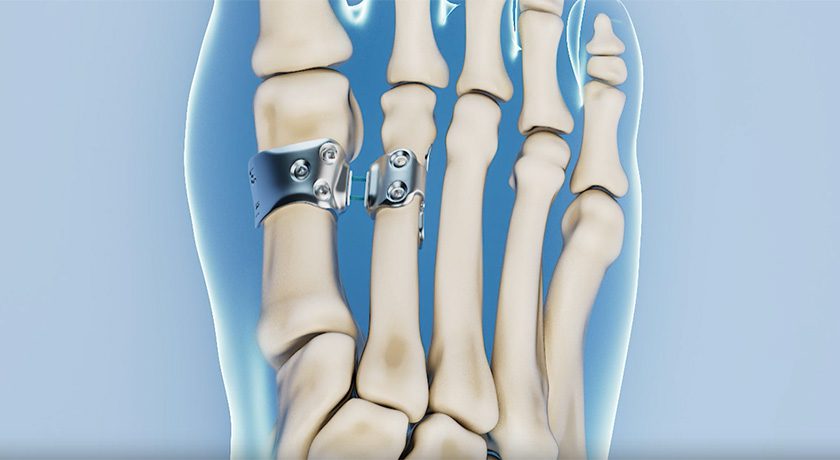

 Copy to clipboard
Copy to clipboard 
The orthopedic market’s sharp recovery on the strength of backlogged procedures lost momentum in the latter part of the third quarter. This deceleration gave way to a dramatic surge in the pandemic that further depressed surgical volumes in the fourth quarter. Early earnings previews from companies reinforce our belief that the orthopedic market will decline around -10% in 2020. Below we’ll preview some positives from the fourth quarter and the most recent COVID and U.S. jobs data, as well as some early thoughts for 2021.
4Q Bright Spots: Robotics and Mid-Tier Spine Companies
We estimate that the overall orthopedic market grew between +0.5% and +1% in 3Q20 compared to the prior year, while growth declined in the low teens for the nine months year-to-date compared to the preceding year. Initial projections for the fourth quarter pointed toward a modest sequential improvement on 3Q, but the worsening pandemic and domestic uncertainty in the U.S. should temper expectations.
However, robotic sales remained surprisingly resilient for some players throughout 2020. Orthopedic robots are concentrated in the knee and spine segments that account for hospitals’ most profitable surgeries. Stryker, for instance, continued its run of success with its Mako system. The company described its second-quarter robot sales as a pleasant surprise, and then Mako passed the 1,000-placement milestone in 3Q20. Stryker expected a “record-setting” fourth quarter for Mako.
Several mid-tier and smaller companies in the spine segment far outperformed the market in the third quarter. For example, Globus Medical grew +10.1% year over year in the third quarter, while ATEC grew +41%. Preliminary 4Q earnings indicate that trend will continue. ATEC’s 4Q growth topped +35%. Amid Medtronic’s significant organizational changes and NuVasive’s Pulse delays, ATEC expects to grow another +25% in 2021. Company CEO Patrick Miles said, “Our 2020 performance gives me great confidence in our ability to continue to earn market share.”
Larger players like Orthofix and Smith+Nephew reported 4Q declines in the single digits, with full-year decreases in the low double digits. We believe that these results are more reflective of the overall market for the fourth quarter.
Fourth Quarter COVID and Jobs Data
As many suspected, the winter months brought a second COVID infection surge. While healthcare systems fared better this time, the sheer scale of the spread impacted surgical procedures worldwide. Restrictions vary widely by geography, but in the U.S. some like major hospitals like Cleveland Clinic in Ohio postponed all non-essential surgeries requiring an inpatient stay through most of December.
November marked a drastic worsening of the pandemic, particularly in the United States, coinciding with the holiday season. The daily average of new positive tests and COVID patients currently on a ventilator more than doubled in November compared to October, according to the COVID Tracking Project. For that same period, current COVID hospitalizations increased by +91%.
Meanwhile, the weakening recovery of the U.S. jobs market finally petered out after seven consecutive months of improvement. The U.S. lost approximately 140,000 non-farm jobs in December, breaking an improvement streak of seven consecutive months. The U.S. unemployment rate held steady at 6.7% in December, almost double the pre-pandemic rate of 3.5% in February.
Exhibit 1 below shows the daily averages of key COVID hospitalization metrics from March 2020 through mid-January 2021, while Exhibit 2 shows the U.S. unemployment rate by month for 2020.
Orthopedic Market Outlook for Early 2021
Given the worsening pandemic and flagging U.S. economy in the fourth quarter, we don’t see the orthopedic market performing much better than our -10% projection for 2020. The CDC projects an additional 92,000 deaths by mid-February 2021 and there is significant uncertainty in the U.S. regarding economic stimulus and a vaccine rollout plan. Considering these factors, we believe the orthopedic market’s growth potential in the first half of 2021 is limited.
Exhibits
Exhibit 1: Daily Average U.S. COVID Hospitalization Metrics by Month – Mar 2020 to Jan 2021
Exhibit 2: Adjusted U.S. Unemployment Percentage by Month – Jan 2020 to Jan 2021
The orthopedic market’s sharp recovery on the strength of backlogged procedures lost momentum in the latter part of the third quarter. This deceleration gave way to a dramatic surge in the pandemic that further depressed surgical volumes in the fourth quarter. Early earnings previews from companies reinforce our belief that the orthopedic market...
The orthopedic market’s sharp recovery on the strength of backlogged procedures lost momentum in the latter part of the third quarter. This deceleration gave way to a dramatic surge in the pandemic that further depressed surgical volumes in the fourth quarter. Early earnings previews from companies reinforce our belief that the orthopedic market will decline around -10% in 2020. Below we’ll preview some positives from the fourth quarter and the most recent COVID and U.S. jobs data, as well as some early thoughts for 2021.
4Q Bright Spots: Robotics and Mid-Tier Spine Companies
We estimate that the overall orthopedic market grew between +0.5% and +1% in 3Q20 compared to the prior year, while growth declined in the low teens for the nine months year-to-date compared to the preceding year. Initial projections for the fourth quarter pointed toward a modest sequential improvement on 3Q, but the worsening pandemic and domestic uncertainty in the U.S. should temper expectations.
However, robotic sales remained surprisingly resilient for some players throughout 2020. Orthopedic robots are concentrated in the knee and spine segments that account for hospitals’ most profitable surgeries. Stryker, for instance, continued its run of success with its Mako system. The company described its second-quarter robot sales as a pleasant surprise, and then Mako passed the 1,000-placement milestone in 3Q20. Stryker expected a “record-setting” fourth quarter for Mako.
Several mid-tier and smaller companies in the spine segment far outperformed the market in the third quarter. For example, Globus Medical grew +10.1% year over year in the third quarter, while ATEC grew +41%. Preliminary 4Q earnings indicate that trend will continue. ATEC’s 4Q growth topped +35%. Amid Medtronic’s significant organizational changes and NuVasive’s Pulse delays, ATEC expects to grow another +25% in 2021. Company CEO Patrick Miles said, “Our 2020 performance gives me great confidence in our ability to continue to earn market share.”
Larger players like Orthofix and Smith+Nephew reported 4Q declines in the single digits, with full-year decreases in the low double digits. We believe that these results are more reflective of the overall market for the fourth quarter.
Fourth Quarter COVID and Jobs Data
As many suspected, the winter months brought a second COVID infection surge. While healthcare systems fared better this time, the sheer scale of the spread impacted surgical procedures worldwide. Restrictions vary widely by geography, but in the U.S. some like major hospitals like Cleveland Clinic in Ohio postponed all non-essential surgeries requiring an inpatient stay through most of December.
November marked a drastic worsening of the pandemic, particularly in the United States, coinciding with the holiday season. The daily average of new positive tests and COVID patients currently on a ventilator more than doubled in November compared to October, according to the COVID Tracking Project. For that same period, current COVID hospitalizations increased by +91%.
Meanwhile, the weakening recovery of the U.S. jobs market finally petered out after seven consecutive months of improvement. The U.S. lost approximately 140,000 non-farm jobs in December, breaking an improvement streak of seven consecutive months. The U.S. unemployment rate held steady at 6.7% in December, almost double the pre-pandemic rate of 3.5% in February.
Exhibit 1 below shows the daily averages of key COVID hospitalization metrics from March 2020 through mid-January 2021, while Exhibit 2 shows the U.S. unemployment rate by month for 2020.
Orthopedic Market Outlook for Early 2021
Given the worsening pandemic and flagging U.S. economy in the fourth quarter, we don’t see the orthopedic market performing much better than our -10% projection for 2020. The CDC projects an additional 92,000 deaths by mid-February 2021 and there is significant uncertainty in the U.S. regarding economic stimulus and a vaccine rollout plan. Considering these factors, we believe the orthopedic market’s growth potential in the first half of 2021 is limited.
Exhibits
Exhibit 1: Daily Average U.S. COVID Hospitalization Metrics by Month – Mar 2020 to Jan 2021
Exhibit 2: Adjusted U.S. Unemployment Percentage by Month – Jan 2020 to Jan 2021

You are out of free articles for this month
Subscribe as a Guest for $0 and unlock a total of 5 articles per month.
You are out of five articles for this month
Subscribe as an Executive Member for access to unlimited articles, THE ORTHOPAEDIC INDUSTRY ANNUAL REPORT and more.
ME
Mike Evers is a Senior Market Analyst and writer with over 15 years of experience in the medical industry, spanning cardiac rhythm management, ER coding and billing, and orthopedics. He joined ORTHOWORLD in 2018, where he provides market analysis and editorial coverage.







